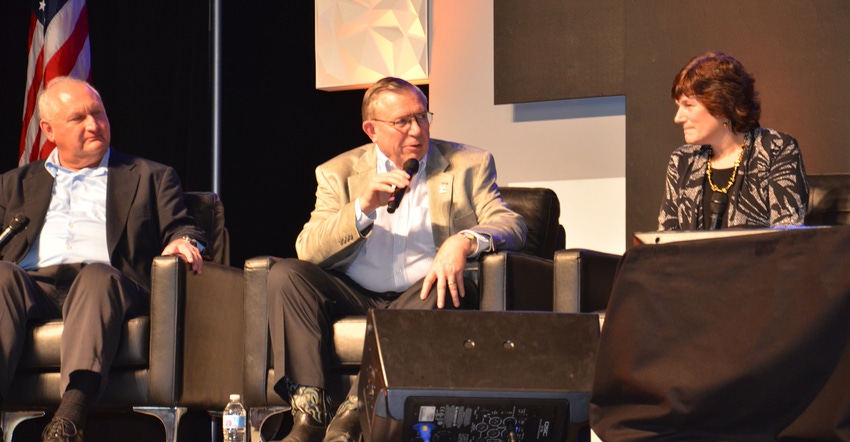February 21, 2019

Five Purdue University College of Agriculture deans and a celebrated farm broadcaster all on one stage is a great recipe for making strong statements!
Deans spanning the past 32 years in the Purdue College of Agriculture included Bob Thompson, Vic Lechtenberg, Randy Woodson, Jay Akridge and current dean, Karen Plaut. Ag broadcaster Max Armstrong, an Indiana native and part of the Farm Progress team, was the moderator for a panel discussion among these leaders at the annual Purdue Ag Alumni Fish Fry. He kept them focused on what a land-grant institution’s role should look like in the future.
Research mission
When Armstrong brought up ag research, the deans pounced.
“It’s one of the key ideas from the Morrill Act, which set up land-grant institutions,” Akridge said. He’s currently serving as Purdue provost.
Setting up experiment stations within land-grant colleges was an integral part of the three-pronged mission of the Morrill Act, Akridge said. The term “experiment station” embodies the concept of agricultural research on important topics of the day.
Today, one of those topics is discovering how to feed more than 9 billion people around the world by 2050, noted Thompson, Purdue Ag dean from 1987 to 1993. His background in ag economics and international studies gives him insight into this mission.
“One in nine people around the globe today don’t have enough money to provide themselves with a 1,650- calorie diet to sustain themselves,” he said. “Global food security is a huge challenge. We need research more than ever to discover how to provide enough food without harming the environment.”
More public research
One major challenge is convincing the public and policymakers that there needs to be more investment in public agricultural research to help make this happen, Thompson said. Several decades ago, public research through land-grant colleges was the major driver compared to private research.
Over the past three decades, there has been a large shift, he said. Private companies and industry now invest a tremendous amount in ag research. While this has produced great advances, Thompson cautioned that lawmakers at state and federal levels need to step to the plate and increase funding for public agricultural research once again.
“We need investment in basic research which will produce benefits down the road,” he said. “Private industry is sometimes more concerned about investing in research that will provide returns more quickly.”
Woodson, now chancellor of North Carolina State University, said what’s happening in his state is an example of how public institutions and private industry can work together. NC State and several large companies collaborate closely, especially on new developments underway centered around Triangle Park.
Coming from a research and teaching background in agronomy, Lechtenberg has always been a strong believer in the public research component laid out by the framers of the Morrill Act.
For her part, Plaut believes research is fundamental. She was and is a driving force behind the Corn and Soybean Innovation Center at the Purdue Agronomy Center for Research and Education. It’s a great example of a public institution (Purdue), industry and farmers (through commodity groups) combining to do far-reaching research for the future.
Comments? Email [email protected].
You May Also Like




